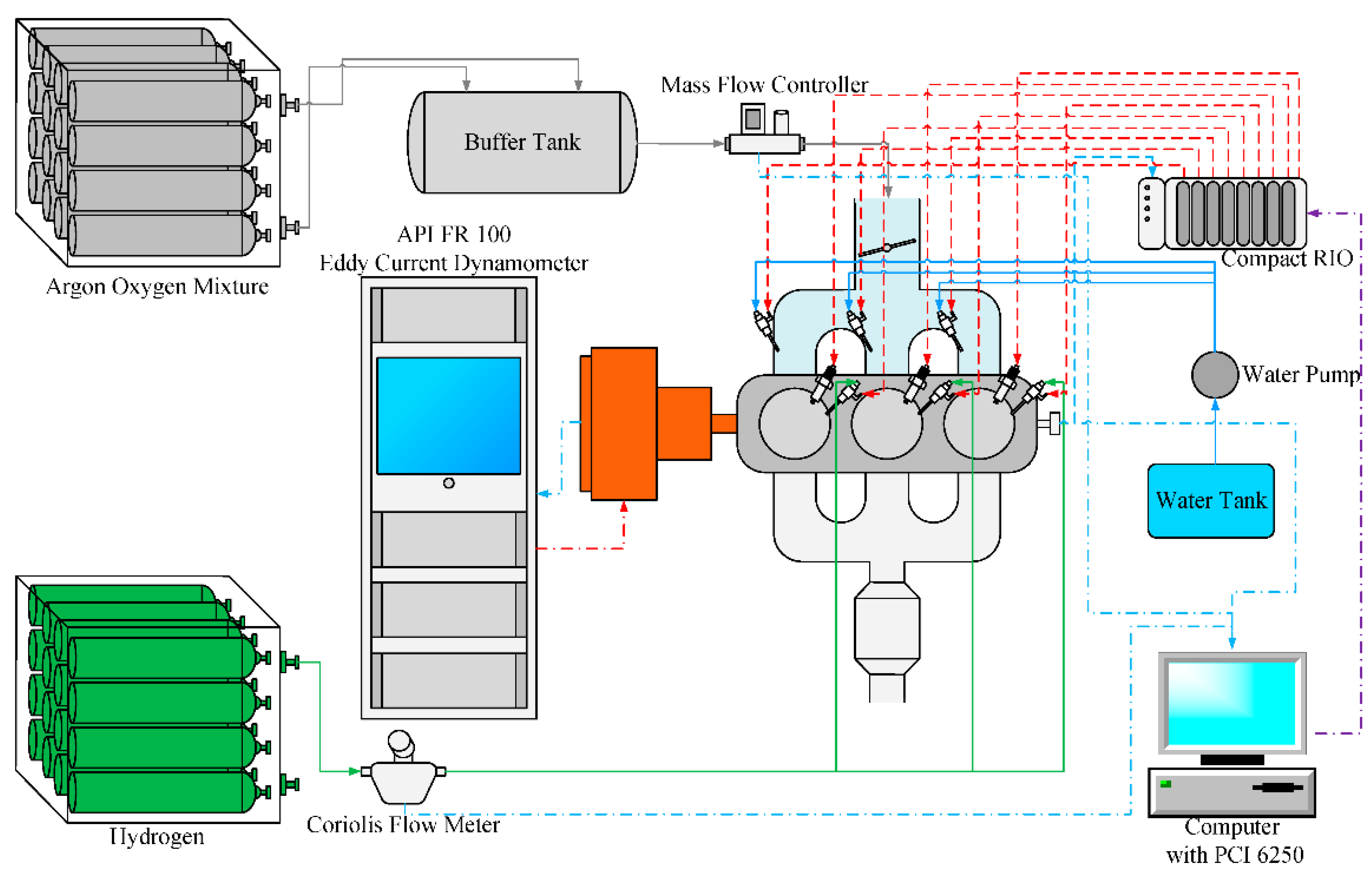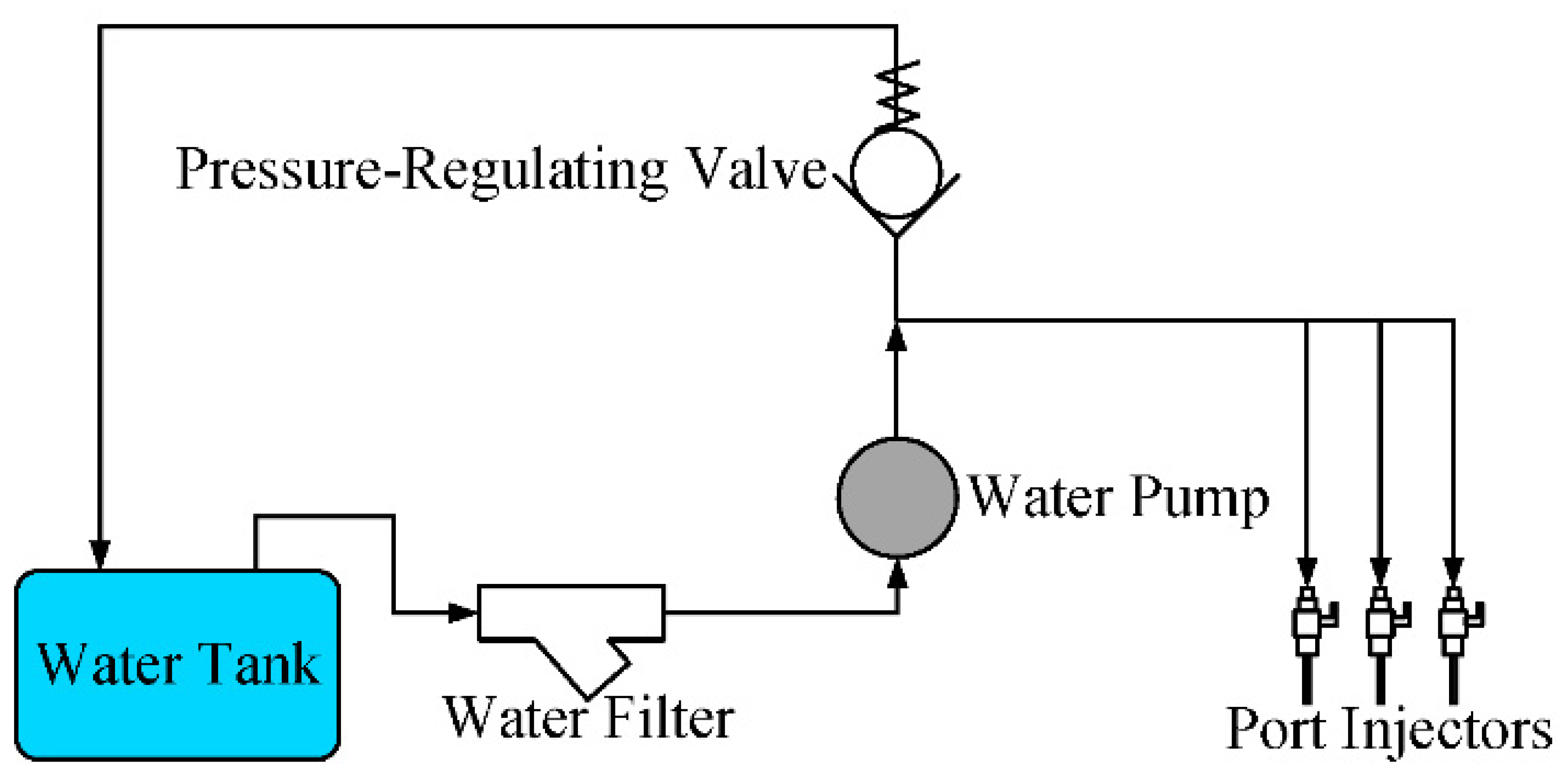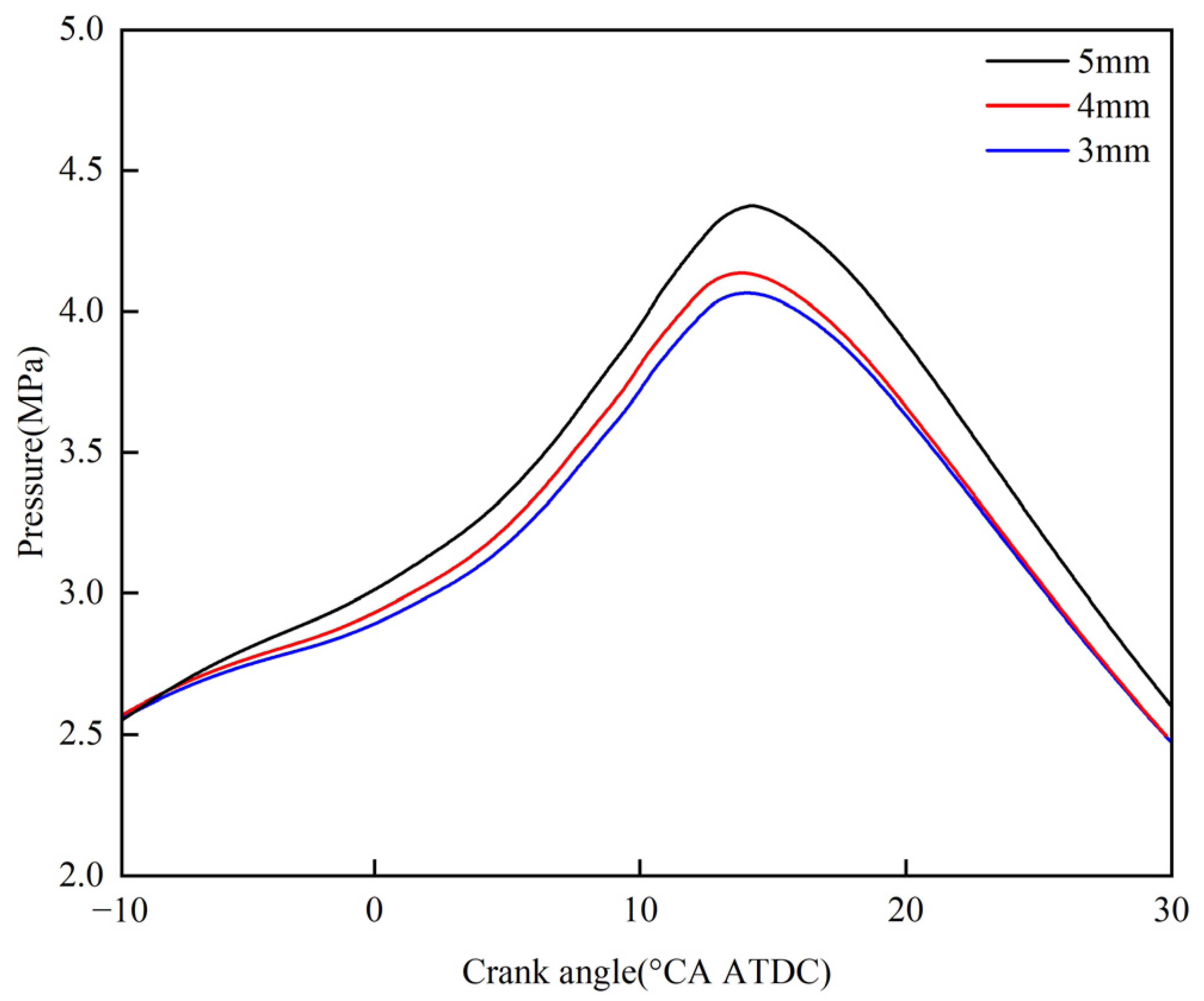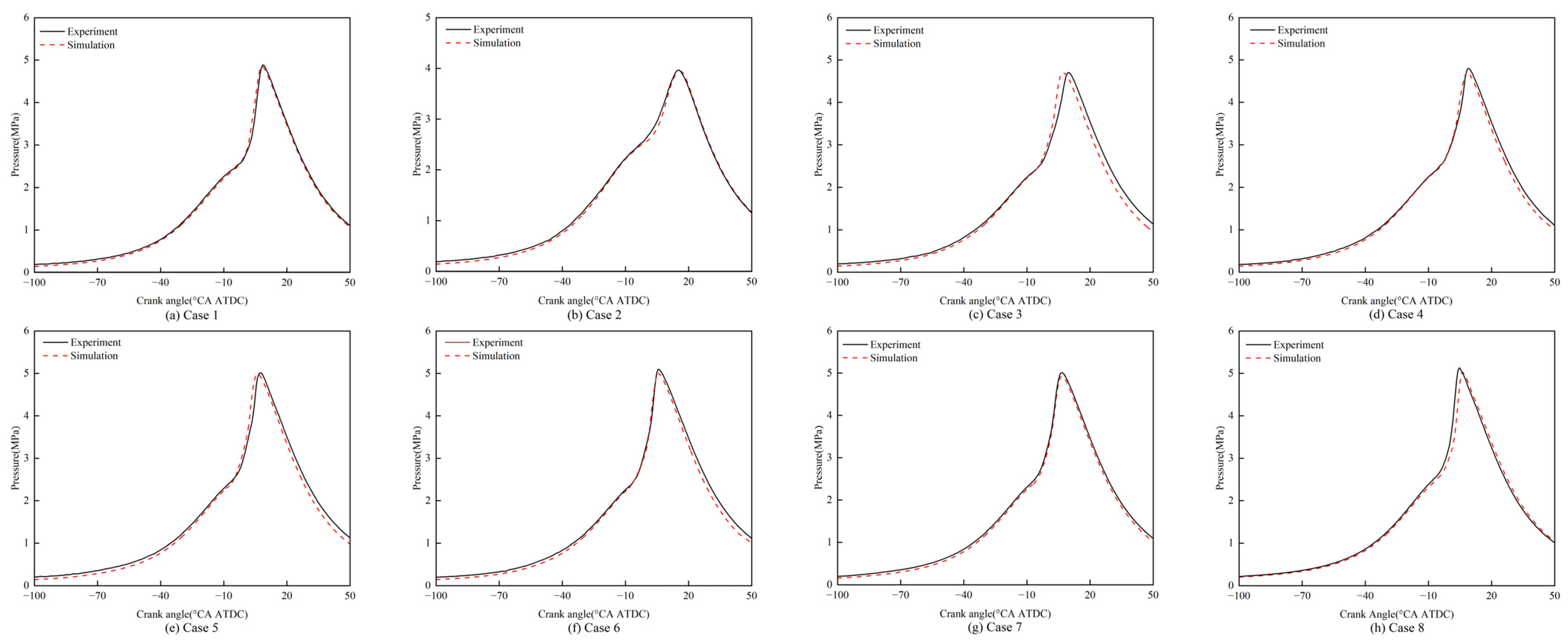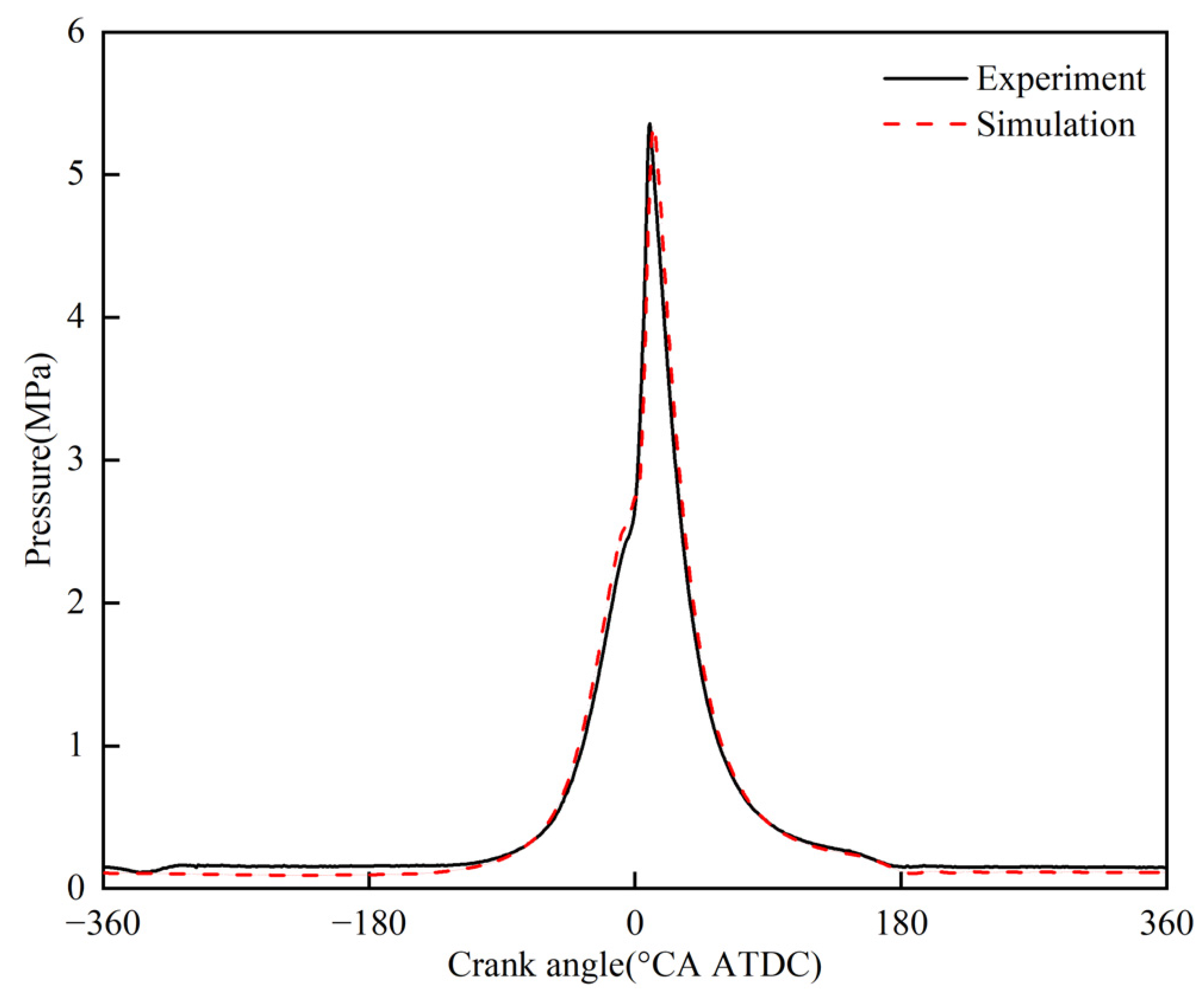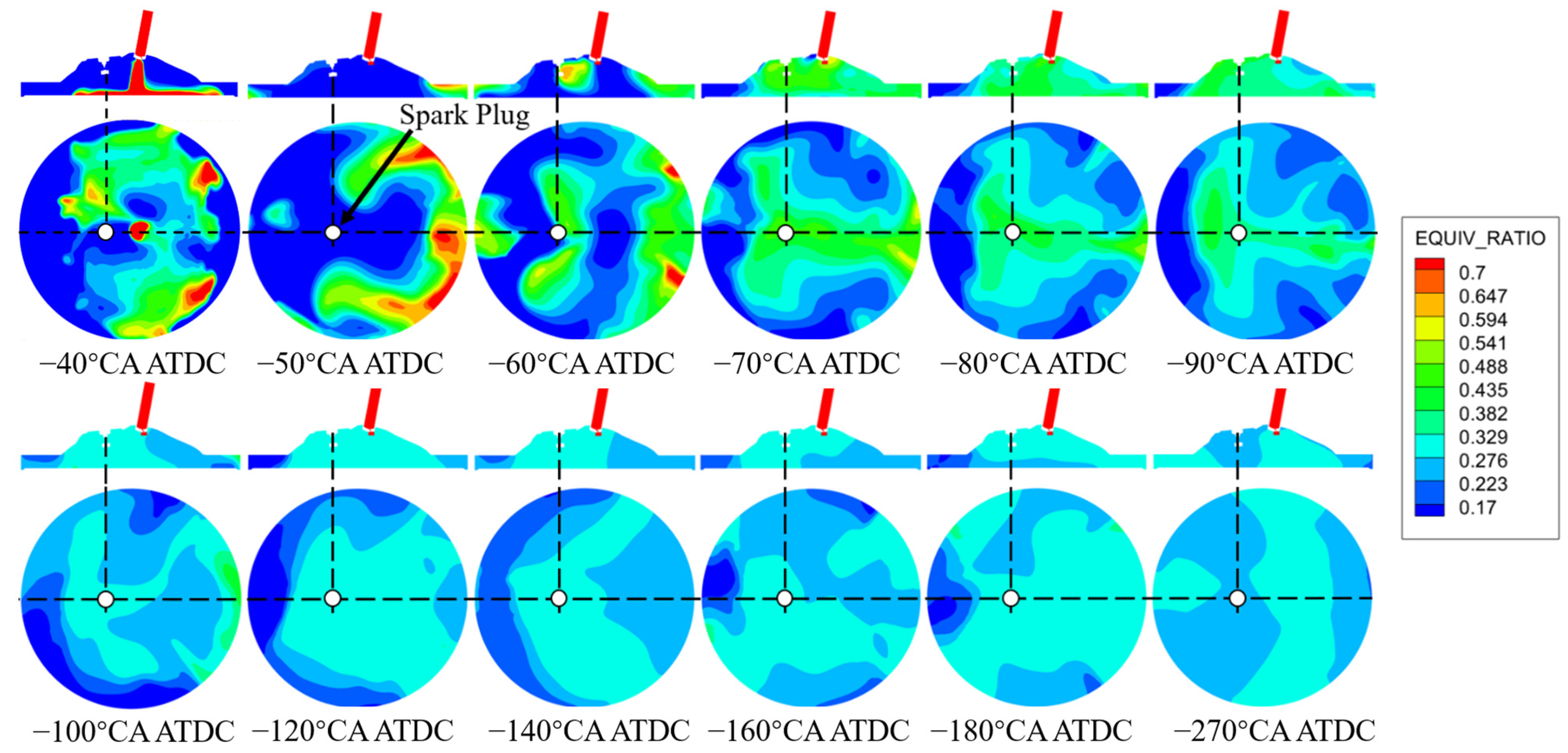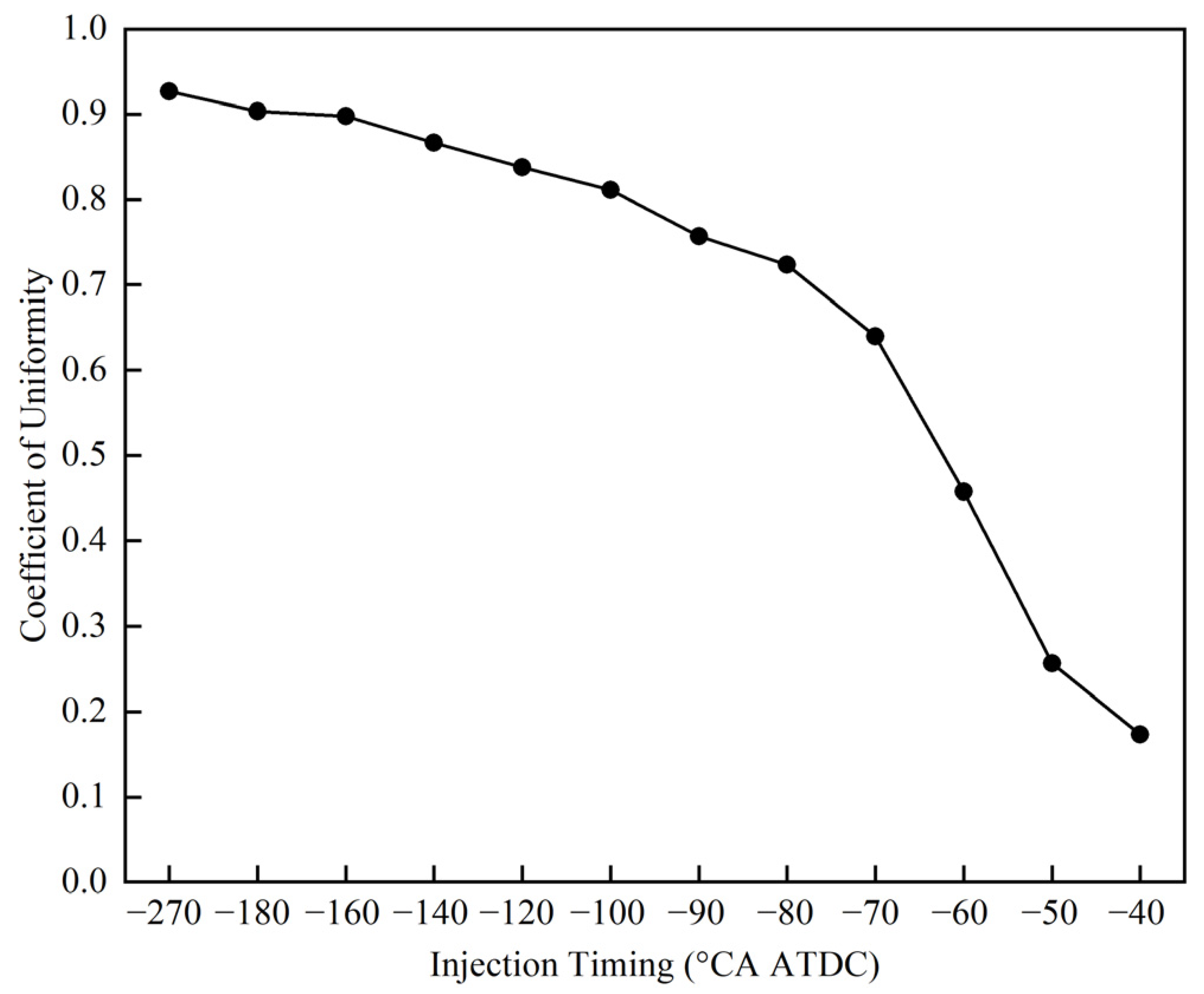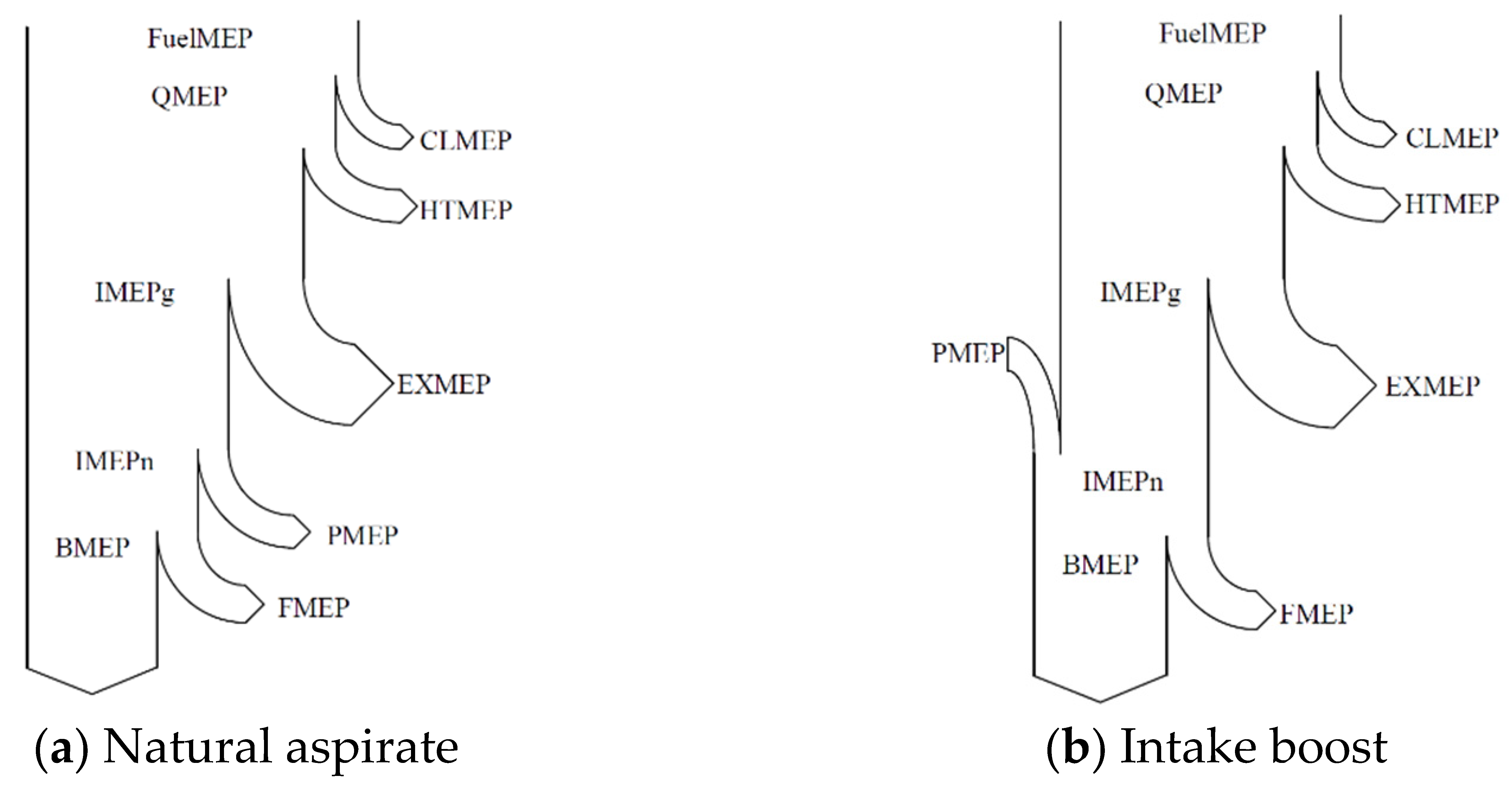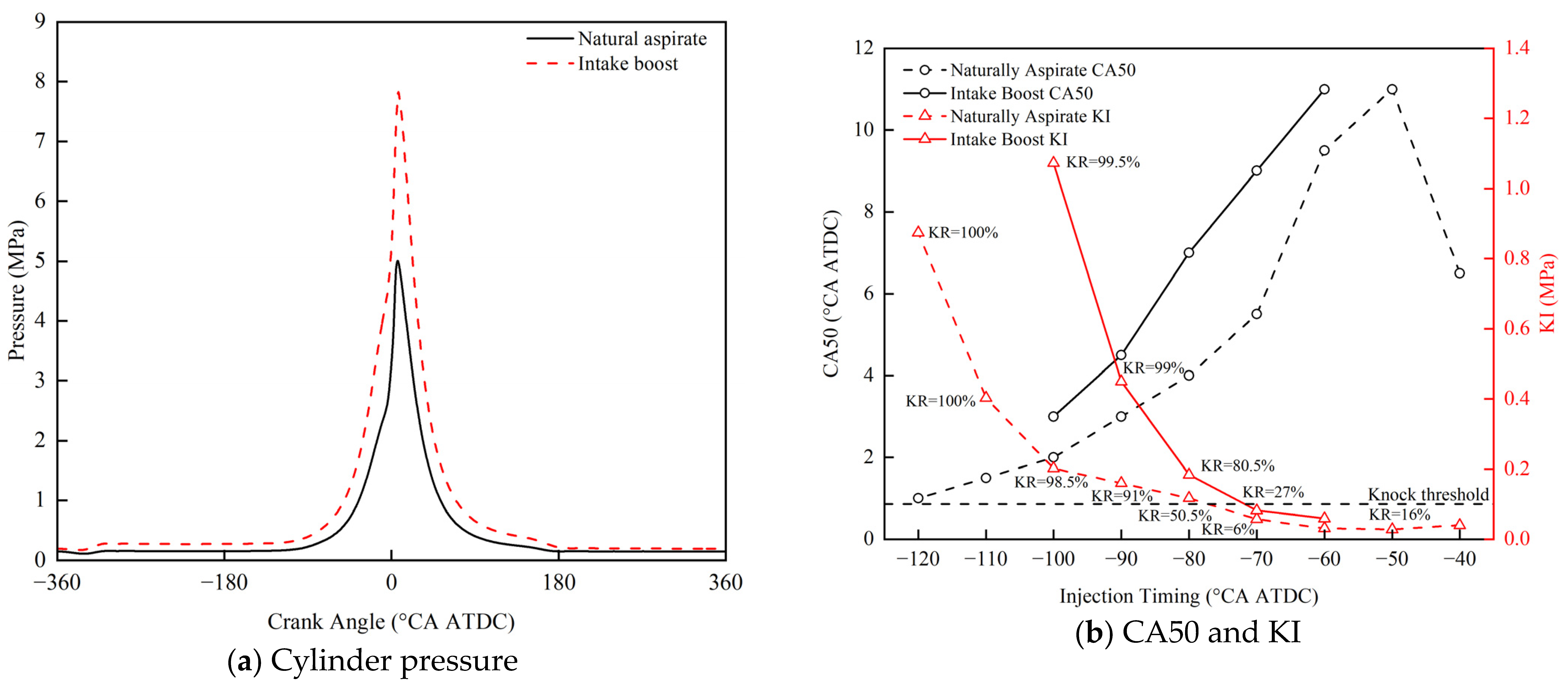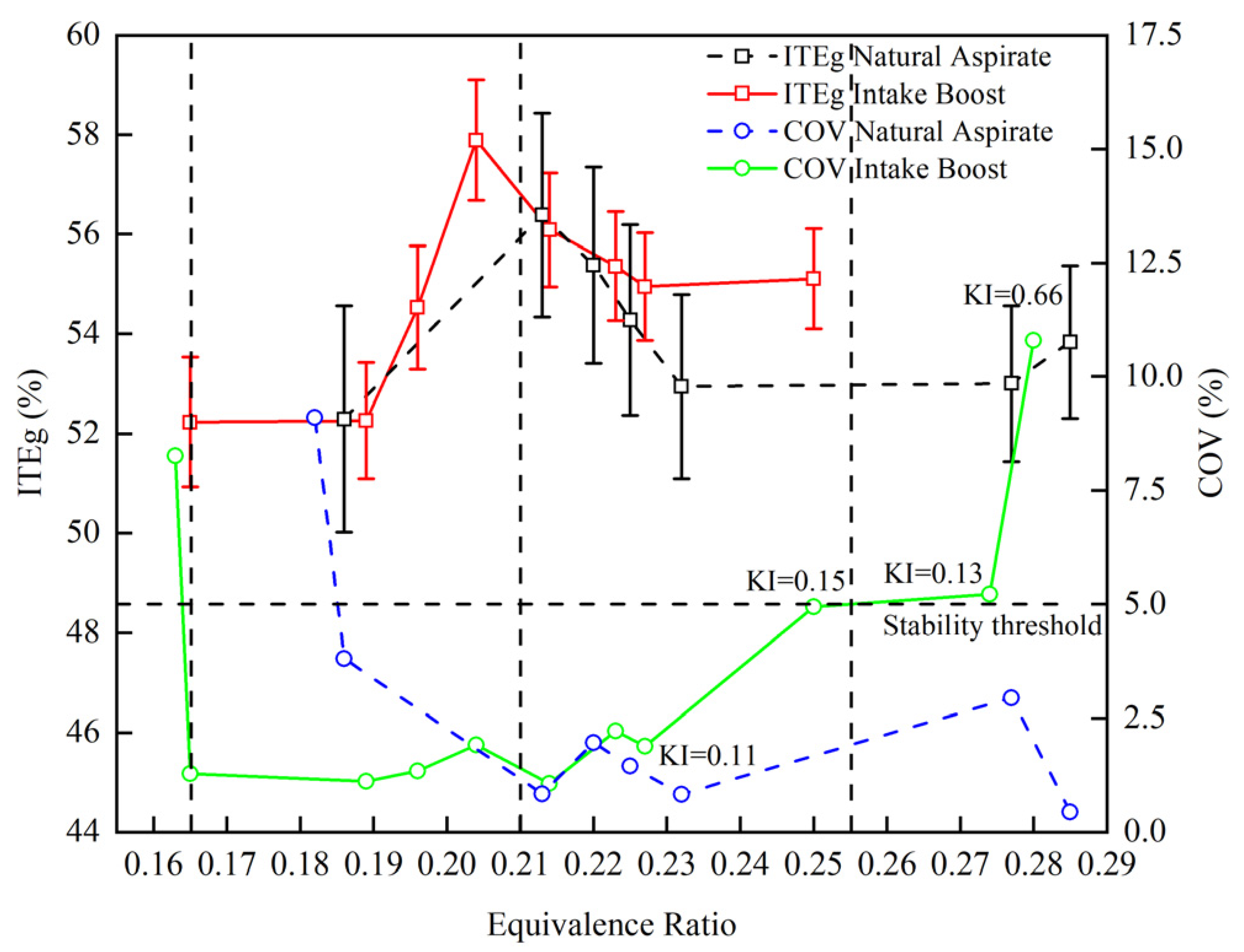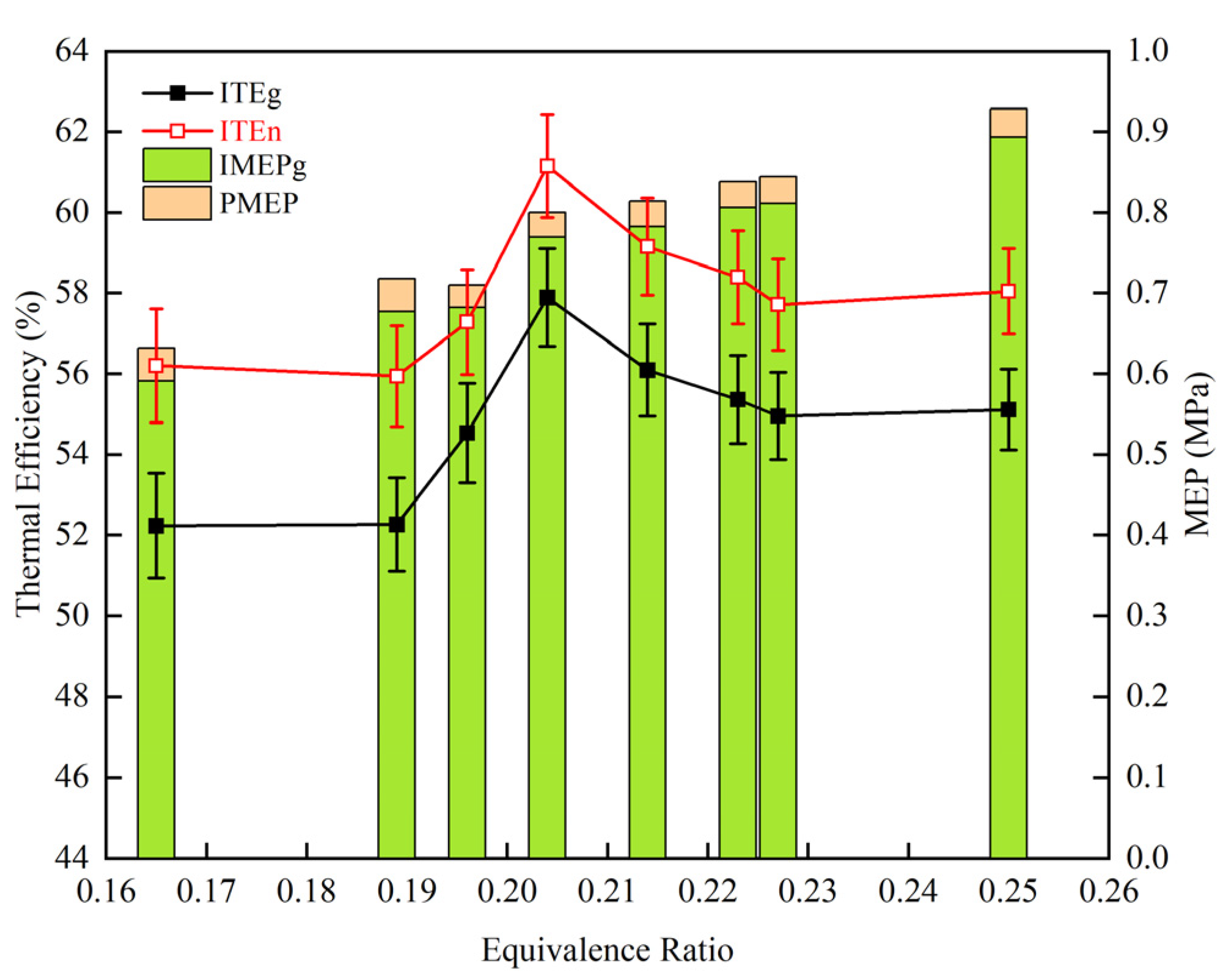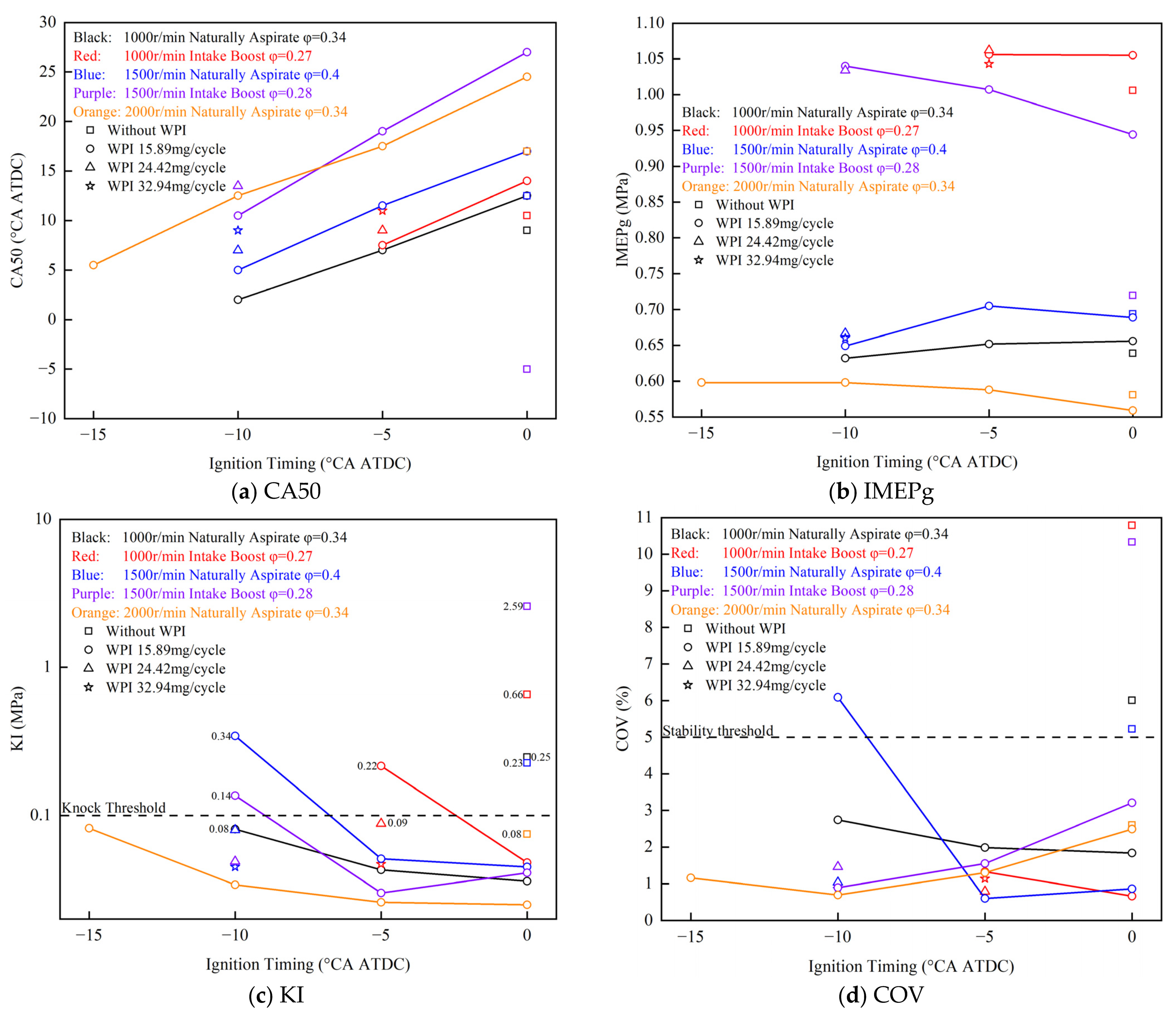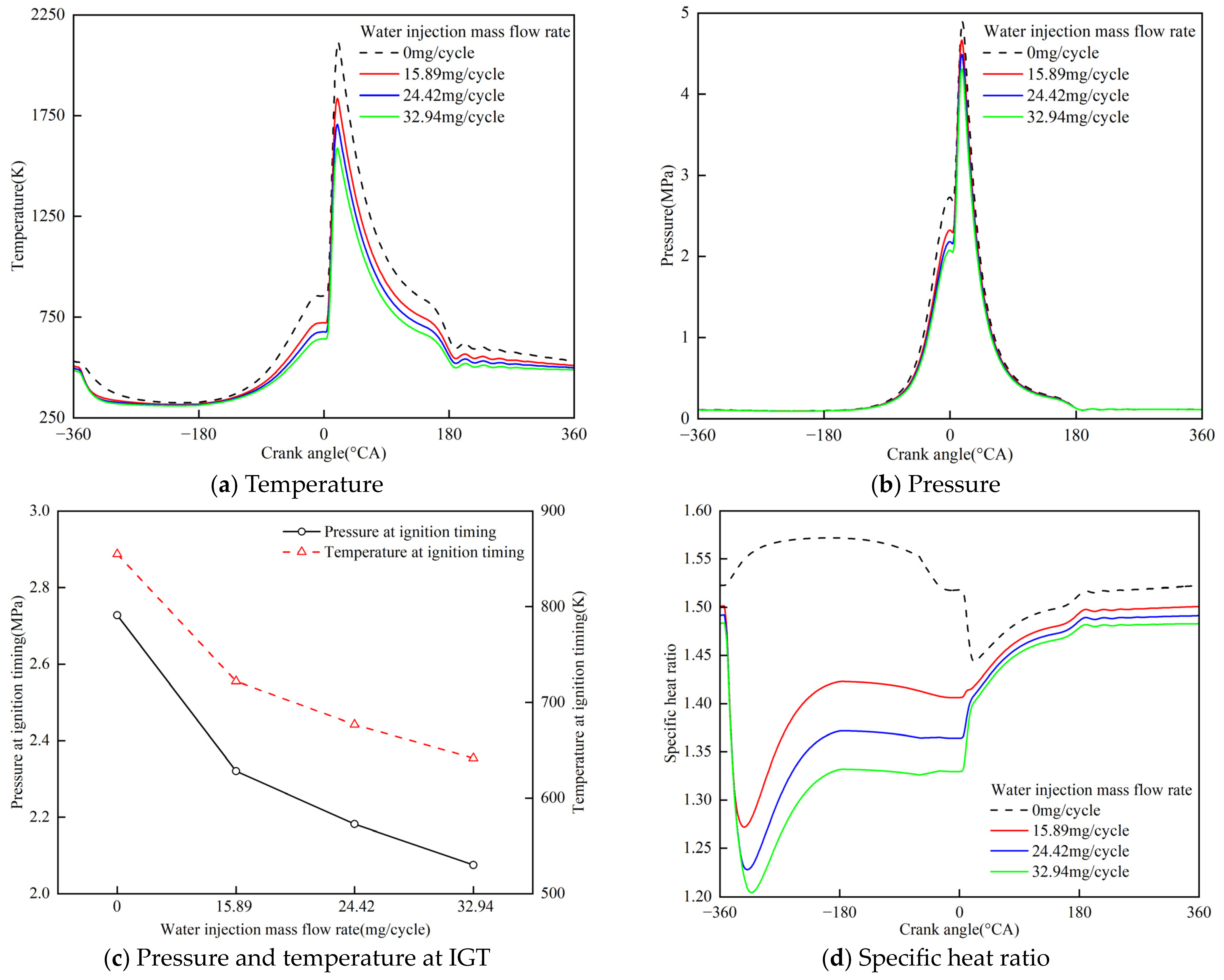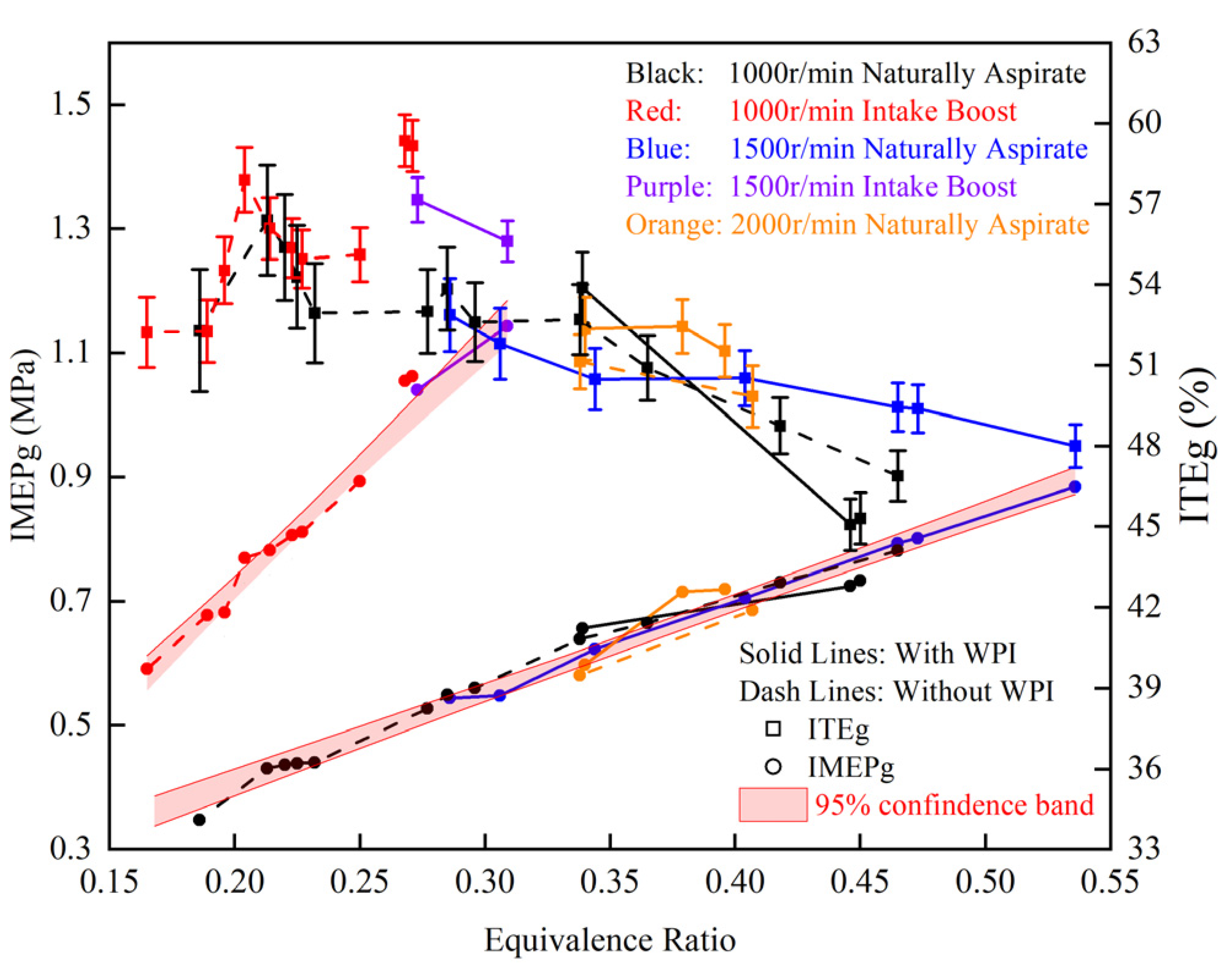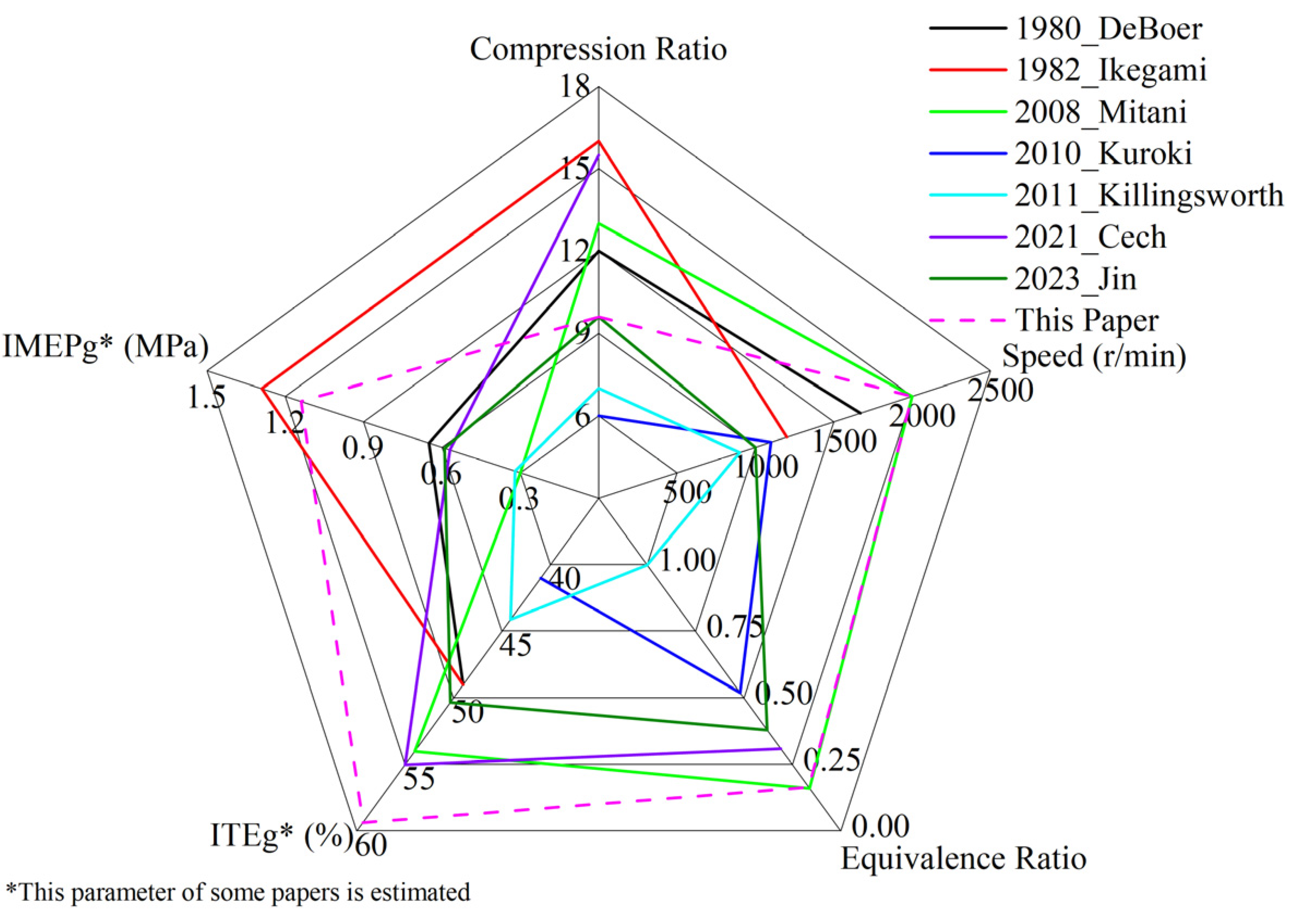3.1. Effects of HDI on APC Hydrogen Engine
In this section, HDI and PHI based on the APC hydrogen engine are compared in the experiment first. The oxidant flow rate (OFR) was controlled to 430 SLPM, so that the intake pressure (absolute) was 0.1 MPa, the hydrogen flow rate (HFR) was variable, and the engine speed was 1000 rpm. The hydrogen INT of PHI was −270 °CA ATDC, while that of HDI was −60 °CA ATDC. IGT was adjusted to maximum brake-torque timing (MBT). However, when the equivalence ratio was 0.365, 0.42, and 0.465, IGT was, respectively, delayed to 5 °CA ATDC, 10 °CA ATDC, and 10 °CA ATDC to evade knock.
Figure 7 shows the IMEP and ITE of the PHI and HDI APC engines with different equivalence ratios in the experiment.
The KR of each condition is marked in
Figure 7. The KI was marked only when it was more than 0.1 MPa, and COV was marked only when it was more than 5%. Under PHI conditions, the APC hydrogen engine can only work stably when the equivalence ratio is between 0.17 and 0.21. Under HDI conditions, when the equivalence ratio is 0.18, the APC hydrogen engine cannot work stably. However, the APC hydrogen engine can work almost without knock when equivalence ranges from 0.18 to 0.29. By delaying IGT, the HDI APC engine can work stably with an equivalence ratio up to 0.42, which means the HDI APC engine works stably with 0.21 < φ < 0.42. Compared with PHI, HDI sharply extended the operating range of the APC hydrogen engine. The ITE of HDI was lower than that of PHI under φ = 0.17 conditions because of an unstable working state. However, with the increase of the equivalence ratio, the ITE of HDI was higher than that of PHI, and the difference in the ITE between HDI and PHI was larger. In summary, HDI can avoid knock at a higher equivalence ratio, resulting in a higher ITE.
To explore the reason for the HDI operating range extension on the APC hydrogen engine, and the influence of the INT of HDI on combustion, further experiments were carried out. Under 1000 rpm speed, OFR = 430 SLPM, HFR = 30 SLPM, and the INTs of PHI and HDI of, respectively, −270 °CA ATDC and −60 °CA ATDC conditions, the CA50 and KI of PHI and HDI with different IGTs in the experiment are shown in
Figure 8. For both PHI and HDI, CA50 was advanced, and the KI was higher with an earlier IGT. However, at an identical IGT, the CA50 of HDI was significantly later than that of PHI.
The experiment results of the CA50 and KI with different INTs of HDI under HFR = 40 SLPM, OFR = 430 SLPM, and −10 °CA ATDC IGT conditions are illustrated in
Figure 9. CA50 was earlier, and the KI was higher with a more advanced INT, except for −40 °CA ATDC INT, i.e., for −40 °CA ATDC INT, CA50 was earlier, and the KI was higher than those of −50 °CA and −60 °CA ATDC INT.
The distribution of hydrogen in the cylinder was clarified through a three-dimensional simulation. Under 1000 rpm speed, HFR = 40 SLPM, OFR = 430 SLPM, −10 °CA ATDC IGT, and −60 °CA ATDC INT conditions, the variation of hydrogen distribution with CA is shown in
Figure 10. According to the PHI experiment, under these conditions, unstable combustion will occur with φ < 0.17. Therefore, 0.17 was the lower limit of φ in this figure.
After INT, hydrogen jets hit the piston top first due to the small nozzle angle. As the piston went upward, hydrogen was compressed and diffused to the cylinder wall, then bounced back to the center of the combustion chamber. If there is a large enough time interval between INT and IGT, the hydrogen jets will go back and forth between the center of the combustion chamber and the cylinder wall several times, and the mixture will eventually reach a homogeneous state.
In this case, the mixture was stratified at IGT. However, unlike conventional stratified combustion, most of the mixture near the spark plug was lean. The rich area was concentrated near the cylinder wall, which is not conducive to flame propagation. The mixture under the PHI condition is considered homogeneous, so fuel burned faster than in the HDI condition (−60 °CA ATDC INT), as shown in
Figure 8. When the overall equivalence is too low, this stratified state will deteriorate combustion, which also explains the unstable working state of HDI under the φ = 0.18 condition, as shown in
Figure 7.
Furthermore, under 1000 rpm speed, HFR = 40 SLPM, OFR = 430 SLPM, and −10 °CA ATDC IGT conditions, simulations with INT ranging from −40 °CA ATDC to −270 °CA ATDC were carried out. Hydrogen distribution at IGT with different INTs is shown in
Figure 11. The text under each image represents the INT.
A dimensionless number coefficient of uniformity (CU) was introduced to quantify the uniformity of the mixture. CU is defined as in Equation (14):
where
is the standard deviation of the equivalence ratio,
is the average value of the equivalence ratio, and the CU of these cases is shown in
Figure 12.
With an earlier INT, the in-cylinder mixture became more homogeneous, as indicated by the higher CU shown in
Figure 12. However, the combustion rate is determined not by CU but by the specific mixture distribution.
Figure 10 illustrates that at the IGT, the mixture surrounding the spark plug for an INT of −50 °CA ATDC was leaner compared to that of the −60 °CA ATDC INT, with a rich region located near the cylinder wall, leading to slower combustion. Conversely, hydrogen accumulated in the center of the cylinder at the IGT with an INT of −40 °CA ATDC, explaining the more rapid combustion observed for the INT of −40 °CA ATDC compared to −50 °CA and −60 °CA ATDC, as shown in
Figure 9.
When the INT was advanced to a position earlier than −70 °CA ATDC, a rich zone with φ > 0.6 no longer existed in the cylinder, and the area of the lean zone with φ < 0.17 was also reduced. This resulted in a more homogeneous in-cylinder mixture, which also accounts for the gradual advancement of the CA50 when the INT was earlier than −60 °CA ATDC, as depicted in
Figure 9. Furthermore,
Figure 12 demonstrates that the CU exceeded 0.8 and slowly increased when the INT was earlier than −100 °CA ATDC, indicating a high level of mixture uniformity in the cylinder. The trends observed in
Figure 9 align with this pattern, as the change in CA50 became less significant when the INT was earlier than −100 °CA ATDC.
In conclusion, HDI in the APC hydrogen engine allows for the formation of a stratified mixture that discourages rapid combustion by adjusting the INT. This effectively addresses the issue of hydrogen burning too quickly in an Ar/O2 atmosphere and helps suppress knock. HDI significantly expands the operating range of the APC hydrogen engine due to its characteristics of combustion retardation and inhibition of backfire.
3.2. Effects of Intake Boost on the APC Hydrogen Engine
To further improve the APC hydrogen engine’s dynamic performance and thermal efficiency with HDI, intake boost is introduced in this section, which enhances the power output while the mixture is not enriched. The intake pressure (absolute) of the intake-boosted condition was set to 0.2 MPa. According to the energy flow model of four-stroke internal combustion engines, different mean effective pressures (MEP) inside the engine are shown in
Figure 13a. In this study, the compression energy of the intake boost was provided outside of the APC hydrogen engine, so the energy flow model was changed, as shown in
Figure 13b.
Fuel MEP (FuelMEP) consists of released heat MEP (QMEP) and combustion losses MEP (CLMEP). QMEP comprises heat transfer losses MEP (HTMEP), exhaust losses MEP (EXMEP), and IMEPg. IMEPg contains IMEPn and pumping losses MEP (PMEP). Finally, brake MEP (BMEP) is IMEPn minus friction losses MEP (FMEP). It can be seen that pumping losses MEP turned into pumping gains MEP (to facilitate comparison, it is still abbreviated to PMEP). To eliminate the influence of external energy on load and thermal efficiency and to better compare intake-boosted and naturally aspirated conditions, IMEPg and ITEg were selected for further analysis.
Under 1000 rpm speed, φ = 0.22, and IGT −10 °CA ATDC conditions, a comparison of the cylinder pressure with the −100 °CA ATDC INT between natural aspirate (OFR = 430 SLPM) and intake boost (OFR = 800 SLPM) in the experiment is shown in
Figure 14a, and the CA50 and KI with different INTs of natural aspirate and intake boost are shown in
Figure 14b.
When the other parameters were the same, the cylinder pressure during the intake, compression, and power strokes in intake-boosted conditions was significantly higher compared to the naturally aspirated groups, whereas there was minimal difference in the cylinder pressure during the exhaust stroke. The intake-boosted group exhibited a maximum cylinder pressure of 7.82 MPa, whereas the naturally aspirated group recorded 5.01 MPa, indicating a substantial increase in the load of the APC hydrogen engine due to intake boost.
Figure 14b presents the KR for each KI point, excluding KR = 0. As the HFR of intake-boosted groups was approximately 1.86 times that of the naturally aspirated groups, the hydrogen distribution within the cylinder significantly differed from each other. Consequently, the CA50 of the intake-boosted groups was higher than that of the naturally aspirated groups, even with the same INT. In the naturally aspirated groups, the KR was zero when the INT was −50 °CA ATDC and −60 °CA ATDC. In contrast, the minimum KR in the intake-boosted groups was 16%. With the advancement of the INT, both the KI and KR in intake-boosted groups increased more rapidly than in the naturally aspirated groups due to the higher load. The KI exceeded the knock threshold when the INT was earlier than −80 °CA ATDC in both groups. In summary, intake boost amplified the load of the APC hydrogen engine and increased the propensity for knock at the same equivalence ratio. The one-dimensional simulation results depicted in
Figure 15 support this observation by demonstrating an increase in the temperature and pressure at ignition timing as the intake pressure rose. For instance, when the intake pressure rose from 0.1 MPa to 0.2 MPa, the temperature at ignition timing surged from 865.96 K to 965.69 K (an approximately 100 K increase), and the pressure at ignition timing elevated from 2.32 MPa to 5.08 MPa. The elevated temperature and pressure levels promoted the occurrence of spontaneous hydrogen combustion, thereby heightening the probability of knock.
The effect of intake boost on the thermal efficiency was analyzed as follows. Under the 1000 rpm condition, trends of ITEg and COV with different equivalence ratios of intake boost and natural aspirate in the experiment are shown in
Figure 16.
The maximum ITEg point with COV < 5% under each equivalence ratio was selected in this figure. If the minimum COV under a certain equivalence ratio was still higher than 5%, which means the APC hydrogen engine could not work stably under this condition, the figure will not show the ITEg of this point. If the KI of a specific point exceeded 0.1 MPa, it will be marked in the figure. The working condition of the APC hydrogen engine at 1000 rpm can be divided into four parts according to different equivalence ratios. When φ > 0.255, due to the knock tendency enhancement of the intake boost, no matter how the parameters are adjusted, the APC hydrogen engine with intake boost cannot work stably (COV > 5%). In contrast, as mentioned earlier, the APC hydrogen engine with natural aspirate can work stably under 0.21 < φ < 0.42. The second part was 0.21 < φ ≤ 0.255, and the KI and COV of intake-boosted groups declined with the decrease of the equivalence ratio, which means that the APC hydrogen engine worked more steadily. The ITEg of both the naturally aspirated and intake-boosted conditions increased with the reduction of the equivalence ratio, and the ITEg of the intake-boosted conditions was slightly higher than that of the naturally aspirated conditions. When the mixture was diluted with 0.165 < φ ≤ 0.21, the COV of the naturally aspirated groups increased as the equivalence ratio decreased, indicating that the in-cylinder mixture was too lean for the naturally aspirated conditions. However, the APC hydrogen engine under intake-boosted conditions still worked stably due to the higher load. The ITEg of intake boost was higher than natural aspirate in this part. In other words, intake boost broadened the lean combustion boundary of the APC hydrogen engine and improved the thermal efficiency under super-lean combustion conditions. The equivalence ratio of the last part was less than 0.165. Under this condition, the mixture was too thin, and even the APC hydrogen engine with intake boost cannot work consistently.
The ITEg tended to increase and then decrease as the equivalence ratio decreased for both intake boost and natural aspirate. Nevertheless, the maximum ITEg occurred at different equivalence ratios. The APC hydrogen engine with natural aspirate had the highest ITEg of 56.39% under φ = 0.213. The APC hydrogen engine with intake boost reached a 57.89% ITEg under φ = 0.204. To sum up, intake boost not only broadened the lean combustion, load, and thermal efficiency boundaries of the APC hydrogen engine, but also introduced a stronger knock tendency, and limited the increase of the equivalence ratio compared with natural aspirate.
The experiment results of the MEPs and the thermal efficiency of the above operating points under intake boost are shown in
Figure 17. IMEPg showed a decreasing trend with the reduction of the equivalence ratio. Since the intake boost pressure was the same, the PMEP of these cases was almost identical, about 0.04 MPa. The difference between ITEg and ITEn was the efficiency caused by pumping gains, ranging from 2.75% to 3.97%.
3.3. Effects of PWI on the APC Hydrogen Engine
In this section, PWI based on the HDI APC engine is implemented. Water INT was set to −360 °CA ATDC. Experiments of PWI under 1000 rpm (both natural aspirate and intake boost), 1500 rpm (both natural aspirate and intake boost), and 2000 rpm (only natural aspirate) conditions were conducted, as listed in
Table 9.
A comparison of the different parameters among the no PWI, 15.89 mg, 24.42 mg, and 32.94 mg water injections per cycle (water injection duration is 2 ms/cycle, 4 ms/cycle, and 6 ms/cycle) conditions in the experiment is shown in
Figure 18.
When IGT was constant, the CA50 was delayed by at least 3.5 °CA with the implementation of PWI. It is worth noting that under the 1500 rpm, intake boost, and IGT = 0 °CA ATDC conditions without PWI, a pre-ignition occurred, leading to CA50 even earlier than the IGT by −5 °CA ATDC. However, with the 15.89 mg/cycle of PWI, pre-ignition was inhibited, and CA50 was substantially delayed from −5 °CA ATDC to 27 °CA ATDC. Furthermore, CA50 was further delayed with an increase in the amount of PWI while keeping the other parameters constant. The comparison of IMEPg among these conditions was more intricate. When examining the 2000 rpm naturally aspirated condition with 0 °CA ATDC IGT, IMEPg decreased with the implementation of PWI because the KI of the no PWI group was lower than the knock threshold. For the 1500 rpm naturally aspirated condition with 0 °CA ATDC IGT, the IMEPg of the no PWI group was slightly higher than that of the 15.89 mg/cycle PWI group. However, for the other three groups, the IMEPg increased at 0 °CA ATDC IGT with PWI due to the higher KI values in the absence of PWI. A similar pattern persisted when increasing the amount of PWI. In summary, KI = 0.22 MPa serves as a critical threshold. When the original condition’s KI is higher than 0.22 MPa, introducing PWI or increasing the amount of PWI will increase the IMEPg, and vice versa. In all five groups, the introduction of PWI and an increase in the PWI amount consistently reduced the KI, which helped to offset the increase in the KI caused by advancing the IGT. Regarding the COV, PWI effectively kept the COV within the stability threshold for all five groups.
In order to elucidate the aforementioned phenomena, the experimental conditions were verified through simulation. Specifically, the natural aspirate condition was maintained at 1000 rpm, while keeping all parameters consistent with Case 1, as detailed in
Table 9, and the IGT was 0 °CA ATDC. Water injection mass flow rates of 15.89 mg/cycle, 24.42 mg/cycle, and 32.94 mg/cycle were employed. The resulting temperatures, pressures, and specific heat ratios for these cases are presented in
Figure 19.
As the water injection mass increased, notable changes were observed in the compression stroke and combustion process. The pressure during compression decreased, alongside a significant reduction in temperature during the compression and power strokes. At IGT, the rise in the water injection mass from 0 to 32.94 mg/cycle resulted in a decline in pressure from 2.73 MPa to 2.08 MPa, accompanied by a decrease in temperature from 854.96 K to 641.79 K. The diminishing pressure and temperature levels led to a decrease in the combustion speed and knock inhibition.
Conversely, an increase in the water injection mass led to a substantial decrease in the specific heat ratio. During the intake stroke under the water injection conditions, the specific heat ratio experienced an initial sharp decline followed by a subsequent increase, whereas the condition without the water injection exhibited a gradual increase. The discrepancies in the specific heat ratio between the intake and compression strokes among these cases were much more pronounced compared to those observed in the power and exhaust strokes. This discrepancy is attributed to the conversion of hydrogen and a portion of oxygen into water after combustion, resulting in a closer alignment between the proportion of water in the power and exhaust strokes compared to the intake and compression strokes. To summarize, the reduction in the specific heat ratio gave rise to a loss of thermodynamic efficiency.
The ITEg and IMEPg boundaries of the APC hydrogen engine with HDI are shown in
Figure 20. The working condition of the APC hydrogen engine was still divided into five groups: 1000 rpm natural aspirate, 1000 rpm intake boost, 1500 rpm natural aspirate, 1500 rpm intake boost, and 2000 rpm natural aspirate. The highest ITEg or IMEPg operating point with COV < 5% of each group was selected.
Figure 20 demonstrates the relationship between IMEPg and the equivalence ratio for both the naturally aspirated and intake-boosted conditions in the APC hydrogen engine experiment. The IMEPgs of the naturally aspirated and intake-boosted conditions, respectively, showed good linearity, and most operating points fell within the 95% confidence band, which means that after optimization, WPI at least did not significantly reduce the dynamic performance of the APC hydrogen engine. In conventional ICE, the operating points of high thermal efficiency and working ability often appear above 2000 rpm. However, limited by the severe knock tendency, even with the application of WPI, the highest thermal efficiency point of the APC hydrogen engine appeared at 1000 rpm, and the expected thermal efficiency improvement caused by the increase in the engine speed did not occur.
PWI raised the maximum equivalence ratio from 0.47 to 0.54 and increased the IMEPg from 0.78 MPa to 0.88 MPa (a 12.82% increase) at different engine speeds under naturally aspirated conditions. In intake-boosted conditions, the maximum equivalence ratio increased from 0.25 to 0.31, and the IMEPg increased from 0.89 MPa to 1.14 MPa (a 28.09% increase) at different engine speeds. However, it is challenging to increase the IMEPg solely by delaying the IGT and increasing the equivalence ratio due to the stronger knock tendency in intake-boosted conditions. PWI proved more effective in intake-boosted conditions than in naturally aspirated conditions. Regarding the ITEg, when the original working conditions involve knock, introducing PWI and adjusting IGT can yield a higher ITEg. For example, under a φ = 0.34, 2000 rpm naturally aspirated condition, the ITEg increased from 51.13% to 52.36% by application of WPI.
PWI had positive effects on the thermal efficiency primarily due to knock avoidance, combustion stability improvement, and heat transfer losses reduction. However, it also had negative effects on the thermal efficiency, primarily due to a reduction in the specific heat ratio and the increase of thermodynamic losses. When the negative effects outweighed the positive effects, the ITEg of conditions with PWI was lower than that of conditions without PWI. For example, the highest ITEg among 1000 rpm naturally aspirated conditions without PWI was 56.39% (at φ = 0.21), whereas the highest ITEg among 1000 rpm naturally aspirated conditions with PWI was 53.89% (at φ = 0.34). Conversely, when the positive effects outweighed the negative effects, the ITEg of conditions with PWI was higher than that of conditions without PWI. For instance, the highest ITEg among 1000 rpm intake-boosted conditions without PWI was 57.89% (at φ = 0.20), whereas the highest ITEg among 1000 rpm intake-boosted conditions with PWI was 59.35% (at φ = 0.27).
3.4. Analysis of the APC Hydrogen Engine Boundaries’ Expansion
In order to assess the impact of different technical approaches on the expansion of thermal efficiency and dynamic boundaries, the parameters of the APC hydrogen engines operating at 1000 rpm are presented in
Table 10. Initially, the substitution of HDI for PHI effectively inhibited knock, resulting in an increase of the maximum ITEg from 54.12% to 56.39%, and of the maximum IMEPg from 0.41 MPa to 0.78 MPa.
Subsequently, the introduction of an increased intake pressure from 0.1 MPa to 0.2 MPa enabled the realization of intake boost. Although this modification led to a rise in the maximum IMEPg from 0.78 MPa to 0.89 MPa, and in the maximum ITEg from 56.39% to 57.89%, the desired enhancements in the IMEPg and ITEg were not fully achieved due to the higher tendency for knock under the intake-boosted condition.
Finally, WPI was implemented to further suppress knock, resulting in a significant improvement in the engine performance. With the application of WPI, the maximum IMEPg reached 1.06 MPa, and the maximum ITEg reached 59.35%.
To clarify the expansion of the APC hydrogen engine boundaries, the previous studies’ results were summarized and illustrated in
Figure 21. The APC hydrogen engine boundaries were evaluated by the extreme values of five parameters, i.e., maximum compression ratio, maximum speed, minimum equivalence ratio under stable working conditions, maximum ITEg, and maximum IMEPg. Unfortunately, some parameters were not revealed in the previous studies, e.g., the minimum equivalence ratio under stable working conditions of De Boer and Ikegami, the maximum IMEPg of Kuroki, and the engine speed of Cech [
6,
7,
10,
11,
15,
16,
17].
Ikegami, Mitani, and Cech [
7,
15,
16] used compression ignition on the APC hydrogen engine and achieved good performance, i.e., Ikegami achieved the highest compression ratio of 16 and IMEPg of 1.29 MPa (estimated), and Mitani [
15] reached the lowest equivalence ratio of 0.161 and a 2000 rpm engine speed, which is higher than other published papers. In further APC hydrogen engine research, a higher thermal efficiency may be available using compression ignition. Only Kuroki [
10] used HDI in the APC hydrogen engine with spark ignition. However, due to the low injection pressure at that time, HDI was performed during the intake stroke, and could not suppress knock.
In this study, the APC hydrogen engine could work stably under 2000 rpm with a 0.72 MPa IMEPg, which is the same speed as that of Mitani [
15] (tied for the highest), but the IMEPg was higher than Mitani’s at 0.3 MPa. The highest IMEPg of this study was 1.14 MPa, which is the second highest among the published papers. The lowest equivalence ratio under stable working conditions was 0.165, which is close to that of Mitani [
15]. It is noteworthy that this study obtained the highest ITEg of 59.35% through the combination of HDI, intake boost, and PWI at a compression ratio of only 9.6, which is the highest ITEg among published papers, and has the potential to further increase the compression ratio and the thermal efficiency.
